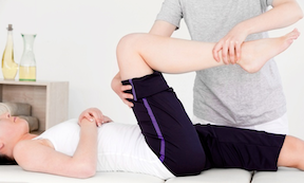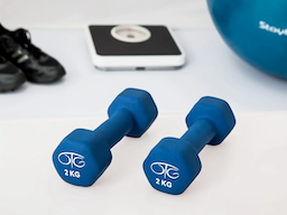Range of Motion Exercises for ALS |
|
|
As ALS progresses, you may experience stiff and tight muscles due to your body moving less on a daily basis. When the muscles around your joints tighten and contract, this can cause stiffness and pain, which can reduce your mobility, flexibility, and ability to complete daily tasks.
You can alleviate joint pain and maintain greater flexibility by doing range of motion (ROM) exercises. Range of motion refers to how much movement you have in each joint. |
|
The goal of these exercises is to stretch your muscles and keep your joints loose to preserve maximum movement.
What are range of motion exercises?
|
ROM exercises are supported stretches that target a specific part of the body, such as your neck, shoulders, hands, hips, knees, or ankles. It is important to perform each stretch in moderation, slowly moving to the point of resistance and stopping whenever you feel any pain. For maximum benefit, perform your prescribed exercises on a daily basis.
|
Positioning
In addition to daily stretching, it is important to be aware of your positioning throughout the day. Poor positioning that doesn’t support the weaker parts of your body can lead to joint stiffness. Pillows, towels, and braces and splints can help support and reposition your joints, both during the day and at night. Changing your position periodically can help reduce stiffness and prevent sores.
Which exercises should I do?
|
As ALS progresses, your exercises will change. When you have the muscle strength to move your joints through their full range of motion, you can do ROM exercises on your own. If one side of your body is stronger than the other, you can use the stronger side to stretch the weaker side. If you become too weak to do the exercises on your own, you will still benefit from passive ROM exercises, which involves the help of a caregiver or professional.
|
|
Ideally, an experienced ALS professional, such as the physical and/or occupational therapist at your local ALS clinic, will create a range of motion exercise regimen tailored to your needs. A different physical or occupational therapist may then come to your home to teach you and your caregiver how to do the exercises.
Keep in mind that the person who comes to your home might not have experience working with ALS patients. If this is the case, remember that no stretch should cause pain or leave you feeling exhausted. Conserving energy is a very important part of managing ALS. If you are uncomfortable with any exercise, speak up at the time and then share your concerns with the physical and/or occupational therapist at your ALS clinic.
Keep in mind that the person who comes to your home might not have experience working with ALS patients. If this is the case, remember that no stretch should cause pain or leave you feeling exhausted. Conserving energy is a very important part of managing ALS. If you are uncomfortable with any exercise, speak up at the time and then share your concerns with the physical and/or occupational therapist at your ALS clinic.
A Note for Caregivers
If your loved one is unable to perform these exercises independently, you can play an important role in helping maintain his or her range of motion, which may reduce pain and discomfort. Ask the physical or occupational therapist how you should help with each stretch so that it is safe and effective. You will want to support the weight of the involved body part, slowly move it through a gentle range of motion to the point of resistance, and back off at the sign of any pain. Allow your loved one to actively participate in the stretch as much as possible.
Upper Body Range of Motion Exercises
Preserving range of motion in the upper body can help you continue to do daily activities. Shoulder stiffness from lack of movement is common and can be very painful when doing things like dressing and transferring. Curled fingers and thumbs can prevent you from grasping and doing a variety of everyday tasks. Upper body range of motion exercises can improve flexibility and function in your neck, shoulders, elbows, wrists, hands, fingers, and thumbs.
|
|
|
Lower Body Range of Motion Exercises
Preserving range of motion in the lower body is particularly important for mobility. Stretching tight calves and Achilles tendons and improving ankle flexibility may help improve walking and lessen foot drop. Common lower body exercises include the runner stretch, hamstring stretch, hip and knee flexion, and ankle flexion.
|
|
|
More on ALS Self-Care
Your ALS Guide developed this page in collaboration with occupational therapist Melissa Werz and physical therapist Laura Good Kennedy from the Duke ALS Clinic.











